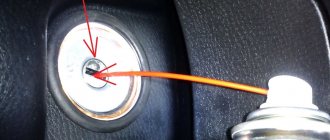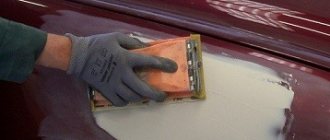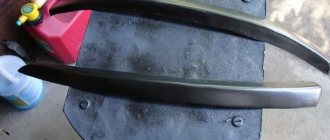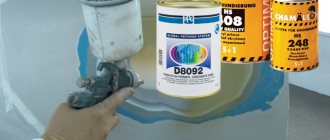Once every three or five years, a car owner faces the important question of choosing a new battery.
Almost all manufacturers guarantee that their products will faithfully serve the user for 7 to 10 years.
In fact, under ideal operating conditions, the battery will need to be replaced much earlier.
Technicians do not stop there and develop new technologies, methods and equipment (for example, hybrid batteries).
What is it, a hybrid battery?
The word “hybrid” itself means the use of a pair or several technological solutions in obtaining a product.
The hybrid battery was developed by combining two equipment manufacturing technologies, which include a crossed composition of the electrolyte properties of such unique substances as calcium and antimony.
A hybrid battery consists of two types of plates. Some are made on the basis of a lead-antimony alloy, others are made on a lead-calcium alloy. To distinguish a regular battery from a hybrid one, you should look at its markings.
The hybrid battery has the inscription Calcium Plus or Ca+ on its body.
Marking
A little more about how hybrid power supplies can be designated.
Each manufacturer chooses its own designations and labeling, which is rather a marketing ploy.
But most often the following inscriptions are found on the battery case:
- Hybrid;
- Ca+;
- Calcium Plus.
The “Ca/Ca” label already indicates that this is an all-calcium battery.
Also, the labeling of hybrids usually contains additional symbols. They indicate how intensively the water in the battery will be consumed.
The following options are possible here, indicated as the last letter of the marking:
- That is Normal. This letter indicates that water consumption will be normal. These are usually the most inexpensive hybrid batteries;
- Stands for Low. That is, the consumption is low;
- Or Very Low. Here the water consumption will be the smallest.
You can also find markings in the form of VRLA. This indicates the presence of a control valve in the battery.
Based on these designations, you can roughly understand how often you will need to service the battery, that is, basically add distilled water to the jars.
Description of hybrid battery technology
The developers chose the advantages of two technologies, combined them and got a new one - a hybrid one.
Thus, the best of calcium and antimony batteries are ideally combined in a hybrid battery. Plates made from a lead-antimony alloy have a positive charge, while lead-calcium plates have a negative charge.
The use of low-temperature calcium in obtaining the required alloy ensures that the finished product, in this case the gratings, is corrosion resistant.
In a hybrid battery, calcium helps reduce the level of electrolyte evaporation and prevents self-discharge of the battery. Antimony in the grid guarantees high resistance to complete discharge.
What is the difference between low-antimony and calcium batteries?
The chemical element called “lead” is quite soft in its properties, therefore, it is not very effective when used alone.
Adding antimony to it will give the plate the required strength. The disadvantage may be boiling of the electrolyte solution, which leads to unwanted evaporation.
This means that you need to regularly add distilled water to the jars.
If the plate contains more than 5% antimony, it is an old model (an improved design has a reduced amount of antimony).
Batteries with low antimony content are low maintenance. The main difference between low-antimony and hybrid devices is the level of evaporation.
The introduction of Ca into a lead-containing lattice instead of antimony is a new direction in the evolutionary development of the battery. It is also known to add a small amount of Ag.
Batteries with Ca-containing plates have a low level of electrolyte evaporation. There are sealed, completely maintenance-free models that have increased capacity and efficiency.
The calcium component ensures low self-discharge of the hybrid battery, as well as the use of a thinner lead grid. They are distinguished by their resistance to complete discharge (which the antimony battery shares with them).
Advantages and disadvantages
Hybrid batteries have significantly more advantages than disadvantages:
- Not only the consumption of the solution is reduced, but also its boiling point.
- Minimal risk of self-discharge.
- High starting current. High efficiency is achieved due to lead-calcium negative electrons. The plates are treated with a special method that prevents oxidative processes and also increases current output.
- Increased resistance to full discharges is ensured by a positive electrode based on lead and antimony.
- The hybrid battery starts easily in winter due to cold cranking current.
Among the shortcomings, only a few facts can be highlighted:
- In hot weather, the user will still have to pour distilled water into the battery.
- A relatively low-antimony hybrid battery is more expensive.
- Fraudsters often choose this equipment for counterfeiting (you need to choose it at specialized retail outlets).
Hybrid battery service
Servicing of a low-maintenance battery is required once a quarter.
To do this, you need to remove the cover, measure the level and density of the electrolyte. If the level is low, then 0.5 liters of distilled water must be added to the electrolyte. A preventive inspection, carried out periodically, will make it possible to prevent any problems with the performance of the battery.
Level control can be carried out visually using a special mark on the body (or on some, the manufacturer installs indicators).
Servicing also includes cleaning of white deposits that contain lead sulfate. It is formed by the chemical interaction of reagents.
Sulfation problem
Since this is a lead-acid battery with a liquid electrolyte, the problem of sulfation for hybrid batteries is more than relevant.
Sulfation occurs when the voltage drops and the density of the electrolyte decreases. It manifests itself in the form of a white coating that settles on the surfaces of lead plates. This is lead sulfate.
Therefore, in order to minimize possible sulfation, it is recommended to try to maintain the battery in working condition, monitor the voltage at the terminals, and also check the electrolyte levels in a timely manner.
But if it was not possible to avoid sulfation, the battery manufactured using hybrid technology is desulfated.
There are several basic desulfation methods suitable for hybrids:
- Pulse cleaning. To do this, you will need a special device called a desulfator. It delivers short current pulses, thereby provoking the gradual destruction and dissolution of lead sulfate in the electrolyte. But the device is expensive, and not everyone decides to buy it for personal purposes.
- Charger with desulfation function. Recently, new chargers have become popular, which have the function of destroying lead sulfate. The cost of such memory devices is higher compared to conventional devices. But the efficiency of their work is quite high.
- Auto chemical goods. Usually it is poured into battery banks, then the battery is connected to the charger. Chemistry reacts with sulfate and destroys it. Then washing is carried out, fresh electrolyte is poured in and normal charging is performed.
- Distilled water. Suitable for cases where sulfation has not significantly affected the plates. You need to drain the electrolyte, pour distilled water into the jars and start the charging process. The water should bubble a little, but not boil away. The water will need to be replaced several times. The downside is that recovery takes quite a long time.
- Mechanical cleaning. Not the most acceptable method, which is best used in extreme cases. The idea is to cut out a piece of plastic on the body, remove the plates, wash them, clean them and put them back in place. Here the integrity of the body is compromised, and it is not so easy to restore it.
- Polarity reversal. It is rightly considered the most last resort when all else fails. The point is simple. You need to connect the battery to the charger, but only connect the plus to the minus, and the minus to the plus. Here either the battery will be restored or completely fail.
Operating period
Like any product, a hybrid battery has a production date and service life.
Ideally, you should buy equipment that was released two or three months before purchase. Of course, you can choose an “older” one, but it is not advisable. Such a device, with regular maintenance, can last, as the manufacturer promises, up to 7 years.
To increase service life and maintain functionality, the correct solution would be to check the level and density of the electrolyte, and timely clean the grid of sulfate deposits.
Life time
When choosing a power source for your car, you should pay attention to the release date. The “fresh” the product, the better. Ideally - 2-3 months from the date of issue.
The advantages of the hybrid type of power supply include a long service life. Most manufacturing plants guarantee stable performance of their tasks for 5-7 years.
To extend the period of operation, it is necessary to check the electrolyte level and clean the grates from sulfates in a timely manner.
Important! The durability of a car's power supply is affected by temperature, the health of the electrical circuit, and even driving style.
Selecting a charger
The wrong choice, charger connection or charging duration is a very important decision that can negatively affect the functionality of the battery:
- The optimal charger voltage ranges from 13.8 to 14.2 V.
- The power of the battery determines the power of the required charger. The maximum charge current depends on the battery capacity, which is determined by the manufacturer.
- The charger must have an adjustable output voltage.
- The reliable charger is equipped with an electric current power limiter.
- Automatic chargers that block the charging process in case of incorrect connection, as well as protect against power surges, are considered universal and very easy to use.
What to look for when choosing a battery
Basic criteria for choosing a battery for a car:
- Date of manufacture, it is recommended to purchase products that have been in warehouses for no more than six months.
- Dimensions of the case and type of fastening; an oversized battery may not fit on the installation site. Since the battery weighs 15 kg or more, it is necessary to ensure reliable fastening; the use of homemade fixing devices is prohibited.
- Polarity, there are products with direct and reverse terminal layouts.
- Housing cover configuration.
- Maintenance frequency (depending on the type of structure). There are car batteries that do not require topping up with water.
Battery terminal layout diagrams.
How to charge a hybrid battery
It is recommended to carry out the charging process by first checking the density of the electrolyte solution.
So, before charging, either the density (to 1.221.22 g/cm3) or the voltage must be reduced to 12 V. Preparation process:
- clean the hybrid battery from dirt;
- open the lid and “release” the gases formed from the boiling of the electrolyte;
- if the liquid level is low, add distilled water;
- connect the charger through the terminals;
- connect transformer power.
After 2 hours, control of just a few indicators:
- the current must be 10% of the battery capacity, and the voltage cannot exceed 14.2 V;
- the density and temperature of the electrolyte solution is not higher than +45 C/
A charged battery has a voltage of 14.2 V and a current of 0.5 A. The user will see bubbles.
After charging, check the electrolyte levels in each jar, add water if necessary and close everything.
Expert advice
In summer, it is especially important to monitor the condition of the hybrid battery. During the warm season, the battery does not experience “cold starts”, consumes little energy and is quickly recharged. Modern car alternators produce a voltage higher than before (14.2 - 14.5 V). Thus, in the summer season, due to high voltage, the battery boils, the water evaporates, the acid concentration increases, the plates heat up and become exposed, which means that the active mass may fall off. To prevent battery damage, check it once a month during the warm season.
Do you want to know what other production technologies are used for batteries and what their features are? Follow the link. (at the bottom of the page)
And for a new battery, go to Delmex!
Restoring a hybrid battery
The hybrid battery can be restored if there are a couple of faults:
- in order to eliminate the consequences of shorting the plate, you need to rinse the battery with distilled water until the carbon particles disappear;
- in order to reduce the sulfation of the plates, it is necessary to either pour special chemicals or connect a weak charge-discharge;
- You can get rid of sulfites by manual cleaning, but without experience you should not do this, as you can damage the plates, and therefore the entire battery.
When special solutions are used to combat sulfite deposits, the technique consists of pouring the solution and keeping it in the battery for two days.
If the battery is frozen, there is no point in restoring it. Outwardly, it looks like this: swelling of the sides, boiling of the electrolyte liquid, or shorting of the plates.
A battery that has been given a huge charge of current is considered non-renewable. This factor must be taken into account when charging the battery. You should only choose an adjustable charger.











